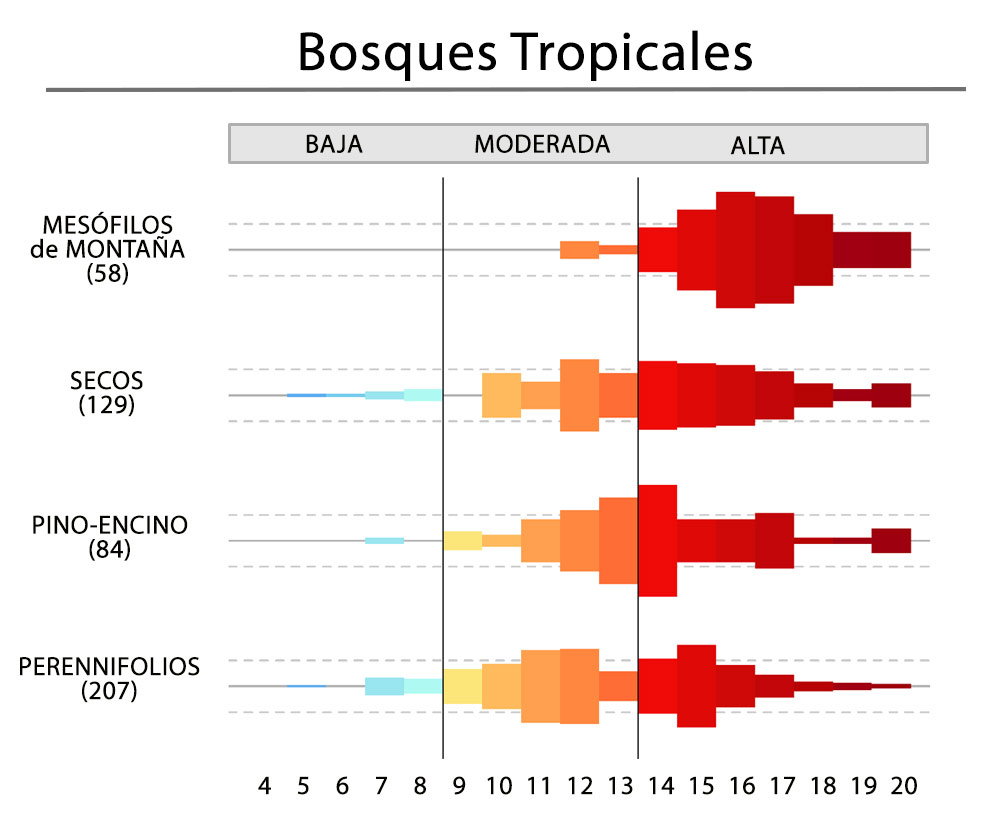Resultados adicionales
La traducción en Español pronto estará disponible.

This section includes more detailed graphical summaries that complement the three-category bar graphs in the main report and provide a more nuanced view of the conservation status of each group. The graphs show the proportions of species in each of the 17 levels of the concern scale (the concern scores range from 4 to 20 and are labeled at the bottom of each graph). These graphs can be interpreted in a similar way to violin plots or a histogram; the size of each of the 17 vertical bars indicates the proportion of species from the group with that concern score. Each vertical bar is centered on the solid gray line, and the two dotted gray lines indicate the size of a bar that would represent 10% of the species in the group.
Note: as previously mentioned, species with a maximum combined score of 13 and a population trend score of 5 were considered high conservation concern and included in the Watch List; for the purposes of all graphs in the report and in this document, these species were graphed as if their CCSmax score was 14 (i.e., to the right of the high-concern threshold line).
The violin plots convey the main messages of the report, but better convey the distribution of scores within the broader categories. For example, in addition to showing that Ocean and Tropical Forest species are in crisis, the violin plots indicate that significant numbers of species in these groups reach the highest possible scores, underscoring the level of concern for the groups. These graphs also highlight the fact that even groups that are doing relatively well overall (i.e., wetlands and temperate forests) also include some species at the highest conservation levels. Finally, the graphs provide a more nuanced ranking of the overall average status of these species groups: for example, although the proportions of species on the Watch List are very similar for Temperate Forests, Tundra, Wetlands, and Boreal Forest, almost all of the high-concern species in the Boreal Forest are only just beyond the high-concern threshold.
This page presents 7 detailed graphs: one to match each of the 7 bar graphs in the main report.
State of North America’s Birds
One-third of all North American bird species need urgent conservation action. These 432 species of high conservation concern are on the Watch List, and are most at risk of extinction without significant action.
More than half of species from Oceans and Tropical Forests are on the Watch List because of small and declining populations, small ranges, and severe threats to their habitats. Many species in Coastal, Grassland, and Aridland habitats are declining steeply. In particular, long-distance migratory shorebirds and species that migrate from the Great Plains to Mexico’s Chihuahuan grasslands have lost, on average, almost 70% of their continental populations since 1970. Most species in Temperate Forests, Tundra, Wetlands, and Boreal Forest are of moderate or low concern, yet roughly 20% are on the Watch List. Waterfowl have benefited from careful harvest management and wetland conservation, but positive waterfowl trends may not last if wetlands loss continues. The Generalist group—birds that are adaptable and can live in multiple habitats—are of lowest conservation concern.

Oceans
The outlook for oceanic birds—including seabirds and a group of landbirds found only on islands off the Mexican coast—is the bleakest of any North American bird group.

Boreal Forest
Most boreal bird species are of low or moderate conservation concern, indicating this is still a relatively healthy habitat. Among the species that are of conservation concern, most are long-distance migrants that face threats on their nonbreeding habitats

Tropical Forests
The majority of resident species in Mexico’s tropical forests are on the Watch List due to small and highly threatened populations. Birds that live in tropical cloud forests atop mountains are most at risk, with many resident species such as the Resplendent Quetzal federally listed in Mexico as endangered. Tropical dry forests are home to 48 endemic species found nowhere else. Tropical evergreen forests are important migratory habitat; 20% of boreal breeding birds spend winters there. Mexican pine-oak forests are important migratory habitat, particularly for birds breeding in western temperate forests.

Temperate Forests
Of the 144 temperate forest bird species in eastern and western North America, 30 are on the Watch List. Western temperate forest birds, on average, are of higher conservation concern, due to smaller ranges and populations than eastern forest birds.

Wetlands
Most wetland bird species are still widespread and common, and are therefore of relatively low conservation concern. Waterfowl populations have grown over the past five decades, helped by effective investments in wetland conservation. Other waterbirds, such as herons, terns, and rails, have also benefited from these efforts. Still, 33 wetland species are on the Watch List, including species that rely on coastal habitats in winter, such as eiders and scoters.
